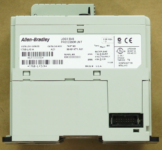
The third generation of CompactLogix controllers began with the release of the L43 back in 2006.
 Designed to bring ControlLogix performance and select features to the CompactLogix line, internally the L4x series shares the same architecture as the 1756-L6x controllers.
Designed to bring ControlLogix performance and select features to the CompactLogix line, internally the L4x series shares the same architecture as the 1756-L6x controllers.
As such, the L4x was the first CompactLogix controller to support motion control (via 1768 Sercos modules,) and was also the only CompactLogix controller to support ControlNet and Ethernet networks simultaneously.
The L4x Family:
 1768-L4x controllers came with a built-in “Channel 0” RS-232 Serial Port, a front facing CompactFlash memory card slot, as well as support for 16 concurrent tasks and local 1769 Compact I/O.
1768-L4x controllers came with a built-in “Channel 0” RS-232 Serial Port, a front facing CompactFlash memory card slot, as well as support for 16 concurrent tasks and local 1769 Compact I/O.
And like all previous CompactLogix controllers, the L4x could be programmed through its serial port via a “Null Modem” Cable (1747-CP3 or 1756-CP3.)
L4x controllers also had a “Mode” Key Switch like previous controllers, but unfortunately it used a hollow “plastic” key that wasn’t nearly as durable as previous keys.
Unlike the L3x controllers, the 1768-L4x controllers didn’t have a second “Channel 1” communication port, and the battery was replaced with a capacitor paired with additional system memory.
In place of a second communications port, L4x  controllers had a new “left hand” bus which supported 1768 Ethernet, ControlNet, and Sercos modules.
controllers had a new “left hand” bus which supported 1768 Ethernet, ControlNet, and Sercos modules.
In fact, all L4x systems start with a 1768 power supply as the left most device, followed by any optional 1768 modules, and ending the 1768 bus with the L4x controller itself.
 And while these third generation controllers had a “default communications” button, it now supported two functions.
And while these third generation controllers had a “default communications” button, it now supported two functions.
If the “default communications” button was pressed while the Controller was already powered on, just like with previous CompactLogix controllers the user’s “Channel 0” settings would be replaced with the defaults.

However, if the button was held down as power was applied, the user’s program in the L4x controller’s memory would be erased.
This new function was added as the L4x no longer had a battery which could be removed to erase the user’s program.
A tale of two controllers, networks, and Sercos modules:
 The L4x line included two controllers options.
The L4x line included two controllers options.
The 1768-L43 controller came with 2MB of user memory and support for two 1768 modules, four position axis, and up to 16 local 1769 Compact I/O modules across two banks.
The 1768-L45 controller came with 3MB of user memory and support for four 1768 modules (limited to a maximum of two Sercos and two comm. modules,) up to eight position axis, and up to 30 local 1769 Compact I/O modules across three banks.
For those looking to add Ethernet to their 1768 system, they had a choice between the 1768-ENBT and 1768-EWEB communication modules.
While both the ENBT and EWEB supported peer to peer communications (programming, HMI, SCADA,) the ENBT could also be used as an I/O scanner, while the EWEB supported custom Webpages and Tag Access via a built-in website.
And as far as ControlNet was concerned, users had the choice between the standard 1768-CNB with a single BNC connector, and the 1768-CNBR redundant media version with two BNC connectors.
So, do you have any L4x systems in your plant, or did you design any systems that used the L4x?
If so, what do (or did) you think of them?
You can share your thoughts and opinions with us by clicking on the comment link below my signature.
Until next time, Peace ✌️
If you enjoyed this content, please give it a Like, and consider Sharing a link to it as that is the best way for us to grow our audience, which in turn allows us to produce more content 🙂
Shawn M Tierney
Technology Enthusiast & Content Creator
Support our work and gain access to hundreds members only articles and videos by becoming a member at The Automation Blog or on YouTube. You’ll also find all of my affordable PLC, HMI, and SCADA courses at TheAutomationSchool.com.
- FactoryTalk Design Workbench First Look, CCW Comparison - December 19, 2025
- Drew Allen of Grace Technologies on Automation, Safety, and More (P256) - December 17, 2025
- Robotics in Warehouse Automation with Erik Nieves of Plus One Robotics (P255) - December 10, 2025

Discover more from The Automation Blog
Subscribe to get the latest posts sent to your email.



